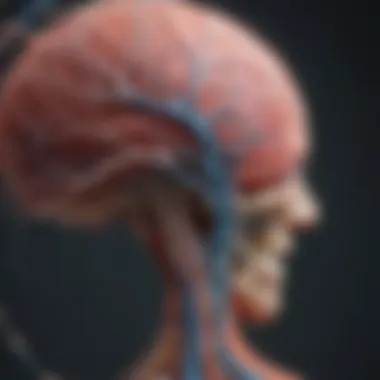Understanding the Complexity of Pain Localization


Intro
Pain is an intricate phenomena that affects quality of life across the entirety of the human experience. Understanding how we localize pain is essential for developing effective treatment and management strategies. It involves various physiological and neurological mechanisms that translate signals from our body into sensations we recognize as pain.
Localizing pain, however, is not a straightforward process. The ability to accurately pinpoint the source of discomfort can be influenced by numerous factors including genetics, the function of nociceptors, and the interplay between psychological elements. As such, pain localization presents a multidimensional puzzle, inviting further examination into the mechanisms that underpin our pain perception.
Key Concepts
Definition of the Main Idea
Pain localization refers to the brain's capacity to identify the specific areas in the body where pain originates. It is governed by a network of nociceptors—specialized receptors that sense harmful stimuli—and the pathways through which these signals travel to the brain. Furthermore, various external and internal factors can affect this localization, making it a complex subject of study.
Overview of Scientific Principles
The process of pain localization begins at the point of injury or insult. Nociceptors, which are dispersed throughout the skin, muscles, joints, and other tissues, react to damaging stimuli by sending signals through the peripheral nervous system to the central nervous system.
Once these signals reach the spinal cord, they undergo several transformations. The information is then relayed to the thalamus—a crucial relay center in the brain—as well as other areas that manage emotional responses to pain.
Pain localization is not merely a sensory experience; it encapsulates the influence of emotional and cognitive factors as well, affecting how individuals perceive and respond to discomfort.
Pain localization is not merely a sensory experience; it encapsulates the influence of emotional and cognitive factors as well, affecting how individuals perceive and respond to discomfort.
Current Research Trends
Recent Studies and Findings
Recent research has significantly advanced our understanding of pain localization. Studies have shown links between genetic variations and individual differences in pain perception and localization. Furthermore, the exploration of chronic pain syndromes has brought to light how previous experiences can shape the pain experience.
Significant Breakthroughs in the Field
Significant breakthroughs have arisen in neuroimaging techniques such as functional magnetic resonance imaging (fMRI), which allows researchers to observe how pain signals are processed in real-time. This technological advancement provides critical insights, aiding in differentiating normal pain processing from that associated with chronic pain conditions.
Understanding Pain Localization
Pain localization is an essential aspect of understanding how humans experience pain. This topic is not just academic but has real-world implications for treatments and individual pain management. It encompasses a range of elements, from biology to psychology, that contribute to the complex phenomenon of pain perception.
The focus on pain localization allows practitioners to address issues more effectively. For instance, when clinicians are aware of how pain is localized, they can create more specific treatment plans. This understanding helps in honing in on the precise causes of pain, leading to better and more individualized care.
The importance of understanding pain localization cannot be understated. It plays a crucial role in many fields, including medicine, neuroscience, and psychology. Each of these areas offers unique insights into how pain is perceived and managed. By integrating these perspectives, we can achieve a more holistic view of pain, enhancing both research and clinical practices.
Moreover, the implications extend beyond mere treatment. Pain localization is linked to mental health. For instance, how an individual perceives their pain can influence their emotional state. Those suffering from chronic pain may experience anxiety or depression, affecting their overall quality of life. Therefore, a comprehensive understanding supports not only physical health but also mental wellness.
Pain is not just a symptom; it is a complex interaction of biological, psychological, and social factors that influences how individuals experience and respond to painful stimuli.
Pain is not just a symptom; it is a complex interaction of biological, psychological, and social factors that influences how individuals experience and respond to painful stimuli.
Definition of Pain Localization
Pain localization refers to the process by which the body identifies the site of a painful stimulus. It is a multifaceted phenomenon involving various biological systems. At its core, this definition encompasses not just the location of pain but also how pain is perceived in relation to different stimuli and contextual factors.


Pain signals are transmitted from the nociceptors through neural pathways to the brain. This results in the localization of pain, allowing individuals to understand where they are experiencing discomfort. Importantly, this process relies heavily on both peripheral and central mechanisms that interpret pain signals.
Historical Perspectives
The historical journey of pain localization has evolved significantly. Ancient cultures recognized pain as a vital clue to injury and disease. However, it was not until the development of neuroanatomy in the 19th century that scientists began to understand the physiological mechanisms behind it.
Early researchers postulated that pain localization relied on a direct line from the body to the brain. Later theories, however, introduced the idea of more complex interactions between various neural systems. These advancements laid the groundwork for modern pain management practices.
The Role of Nociceptors
Nociceptors are specialized sensory receptors responsible for detecting painful stimuli. They play a critical role in pain localization by transmitting signals regarding potential damage or threats to the nervous system.
There are several types of nociceptors, each responding to different forms of harmful stimuli. For instance:
- Mechanical nociceptors respond to pressure or injury.
- Thermal nociceptors detect extremes in temperature.
- Chemical nociceptors are activated by harmful chemicals released during injury.
These nociceptors convert external stimuli into electrical signals that travel through peripheral nerves to the spinal cord and then to the brain. Understanding how nociceptors function adds depth to the overall comprehension of pain localization, highlighting their essential role in signaling pain across varying contexts.
Physiological Mechanisms
The understanding of physiological mechanisms surrounding pain localization is critical. This field integrates various processes that convert nociceptive stimuli from the body into recognizable pain signals. Understanding these mechanisms provides insights into how we can manage and treat pain more effectively. This knowledge is particularly beneficial for healthcare providers, researchers, and those involved in pain management therapies. The complexity of these mechanisms emphasizes the need for individualized approaches to pain treatment. It is not merely about alleviating pain; it is about understanding its very nature and origins.
Neural Pathways of Pain
Neural pathways play an essential role in how pain signals travel from the site of injury to the brain. These pathways include a series of nerve fibers that transmit electrical impulses. A few main types of fibers are involved: A-delta fibers and C fibers. A-delta fibers are responsible for transmitting sharp, acute pain, while C fibers transmit dull, throbbing pain. This difference in speed and type of nerve transmission impacts how pain is perceived and localized.
Furthermore, these pathways can be influenced by several factors such as inflammation, injury, and even emotional state. Issues along the pathway can lead to abnormal pain sensations, known as neuropathic pain. Therefore, understanding these pathways can aid in addressing specific pain types and developing targeted interventions.
Central Processing in the Brain
The brain's processing of pain involves numerous regions that collaborate to give context and meaning to pain experiences. The thalamus acts as a relay station for pain signals, directing them to various cortical areas, including the somatosensory cortex, which is responsible for the sensory perception of pain.
Additionally, the anterior cingulate cortex plays a vital role in the emotional aspect of pain, which influences how pain is perceived. Here, pain is not just a physical sensation but one laden with emotional significance. Understanding these processes allows for greater insight into why some individuals experience chronic pain, while others do not. The central processing of pain reveals a complex interplay between sensation, emotion, and cognition.
Peripheral vs. Central Pain Localization
Pain localization can be divided into two categories: peripheral and central localization. Peripheral localization occurs at the site of injury where nociceptors are activated, providing immediate feedback about potential harm. It is often linked to acute pain that arises from specific injuries or conditions, such as a sprain or a cut.
In contrast, central pain localization involves higher brain functions that interpret pain signals. This aspect becomes clearer in chronic pain situations, where the original injury may have healed, yet the pain persists. Chronic conditions can result from central sensitization, where the nervous system becomes overly reactive to pain stimuli.
Overall, understanding the distinction between peripheral and central pain localization is crucial for accurate diagnosis and treatment options, paving the way for more effective pain management strategies in clinical practice.
Factors Influencing Pain Perception
Pain is not merely a sensory experience; it is profoundly shaped by various factors beyond the physical damage itself. Understanding pain perception requires a comprehensive view that includes genetic, psychological, and cultural influences. This article will discuss how these elements interact to affect the way pain is experienced and localized.
Genetic Variability
Genetic variability plays a fundamental role in pain perception. Different individuals may experience the same painful stimulus differently due to their genetic make-up. Research indicates that specific gene variants can affect the expression of nociceptors, the sensory receptors responsible for transmitting pain signals. For instance, the COMT gene is associated with the breakdown of dopamine, a neurotransmitter that modulates pain perception. Individuals with certain variants of this gene may report higher pain sensitivity.
Additionally, polymorphisms in the OPRM1 gene, which encodes for the mu-opioid receptor, influence pain tolerance and responses to opioid medications. Understanding these genetic factors is crucial for developing personalized pain management strategies. By identifying genetic markers, healthcare providers can tailor treatments that are more effective based on individual pain experiences.


Psychological Factors
Psychological factors also significantly impact pain perception. Emotions such as anxiety, depression, and fear can amplify the feeling of pain, altering the pain experience. This phenomenon is known as the biopsychosocial model of pain, which emphasizes the interaction between biological, psychological, and social factors.
Cognitive factors, such as attention and expectation, can also play a role. If a person anticipates pain or focuses on it intensely, their perception of pain may be heightened. Cognitive-behavioral therapy has been shown to help some patients manage their pain by addressing these psychological components. In sum, understanding the psychological context of pain is essential for effective treatment and pain management.
Cultural Influences
Culture influences how pain is perceived, expressed, and managed. Different cultures have varying beliefs about pain, including its causes and appropriate responses. For example, in some cultures, expressing pain is seen as a weakness, while others may encourage open expression as a means of seeking help. These cultural norms can shape how individuals report and cope with pain.
Moreover, cultural background can affect access to pain relief and healthcare resources. In Western societies, there is often a focus on pharmacological interventions, while other cultures might emphasize herbal remedies or community support. Understanding these cultural dimensions is crucial for healthcare providers to deliver culturally competent care.
"When addressing pain, one must consider the multi-dimensional influences that surround the individual. Ignoring these factors can lead to inadequate care and treatment outcomes."
"When addressing pain, one must consider the multi-dimensional influences that surround the individual. Ignoring these factors can lead to inadequate care and treatment outcomes."
In summary, the perception of pain is not solely a physiological process but is intricately linked to genetic, psychological, and cultural factors. Acknowledging these influences is vital for advancing the understanding of pain localization and improving pain management practices.
The Role of the Brain in Pain Localization
The study of how the brain localizes pain is central to understanding the complexity of pain itself. The brain not only processes pain signals but also interprets them, contributing to our overall perception of pain. This task is not as simple as it seems; it requires integration of sensory input from various sources. The significance of exploring this topic lies in the intricate interplay between different brain regions and their respective functions in pain perception.
Cortical Representation of Pain
Cortical representation of pain refers to how different areas of the cerebral cortex correspond to various aspects of pain perception. The primary somatosensory cortex, for instance, plays a crucial role in identifying where pain is felt. This area processes the spatial aspects of pain, helping individuals determine the location and intensity of pain sensations. The representation is not static; it can change based on prior experiences or injuries. For example, neuroplasticity means that if someone consistently experiences pain in a specific area, their brain may reorganize itself to perceive that area differently.
Studies using imaging techniques such as functional MRI have shown activation in specific cortical regions when pain is induced. This method allows researchers to observe how the brain identifies and responds to pain, contributing to our understanding of conditions like chronic pain. Analyzing these patterns aids in developing targeted treatments that focus on the appropriate brain areas.
Subcortical Structures and Pain
Subcortical structures also significantly contribute to pain localization. Areas such as the thalamus and basal ganglia are essential in filtering and relaying pain information to the cortex. The thalamus acts as a gateway for sensory signals, prioritizing which signals reach conscious awareness. It ensures that relevant pain stimuli capture our attention while suppressing background noise.
Furthermore, the emotional and motivational dimensions of pain are linked to subcortical structures. The limbic system, for instance, influences how pain is experienced emotionally. This underscores the importance of understanding that pain is not merely a physiological response; it involves emotional responses and psychological perceptions. For conditions like fibromyalgia or chronic headaches, the interplay of these factors can lead to more personalized treatment options.
Influence of Emotion on Pain Localization
Emotions have a complex relationship with pain localization. When a person experiences pain, their emotional state can significantly alter how pain is perceived. Anxiety, for example, may heighten pain sensitivity, leading to an exaggerated perception of pain intensity. Conversely, positive emotional states can act as buffers, reducing the pain perceived in certain situations.
Research has shown that the anterior cingulate cortex, which is involved in emotional regulation, also has a role in pain perception. If this area is activated, it may intensify the feeling of pain. This interaction suggests that treating emotional issues could provide relief for those suffering from persistent pain.
"Pain is not just a physical sensation; it is a complex interplay of sensory input and emotional experience, deeply intertwined in the brain's narrative."
"Pain is not just a physical sensation; it is a complex interplay of sensory input and emotional experience, deeply intertwined in the brain's narrative."
Understanding the role of both cortical and subcortical structures in pain localization, alongside emotional influences, reveals the complexity behind pain perception. This knowledge is vital for advancing clinical approaches in pain management, leading to more effective and tailored therapeutic strategies.
Clinical Implications of Pain Localization
The importance of understanding pain localization extends beyond theoretical discussions. Recognizing the clinical implications of how pain is localized can enhance diagnosis and treatment strategies, ultimately improving patient outcomes. Pain is inherently subjective, and individual experiences can differ dramatically. This complexity necessitates a multifaceted approach in clinical practice, aiming to accurately assess and manage pain.


Assessment Techniques
Effective diagnosis begins with robust assessment techniques. Various tools and methods are available to clinicians for understanding pain localization. One common approach is the use of pain maps. Patients can mark areas of discomfort, providing visual insight into pain spread and intensity. This subjective data is instrumental for clinicians to determine potential underlying conditions.
Furthermore, questionnaires like the Brief Pain Inventory or the McGill Pain Questionnaire offer structured ways to evaluate pain characteristics. These instruments facilitate a comprehensive view of the patient’s experience, encompassing severity and emotional impact. In addition to these subjective assessments, advanced neuroimaging techniques are emerging as valuable assets. Techniques such as functional MRI and PET scans allow clinicians to observe brain activity in response to pain, yielding a deeper understanding of pain processing. Overall, accurate assessment techniques empower healthcare professionals to tailor interventions to individual needs.
Individualized Pain Management Strategies
Following accurate assessment, the development of individualized pain management strategies becomes essential. Pain management is not a one-size-fits-all solution. Strategies should reflect the complexity of pain experiences while considering the physiological and psychological components involved.
For instance, multidisciplinary teams can create customized plans that incorporate pharmacological, psychological, and physical therapies. Patients might respond differently to medications. Therefore, regular monitoring and adjustments are vital. Moreover, non-pharmacological methods, such as cognitive behavioral therapy, physical therapy, or alternative therapies like acupuncture, can provide relief tailored to individual patient profiles.
An important aspect of any individualized approach is ongoing communication between patient and clinician. Patients who feel heard and understood may engage more actively in their treatment, leading to improved adherence and outcomes.
Impact on Treatment Outcomes
The implications of pain localization on treatment outcomes cannot be overstated. An understanding of how a patient perceives and localizes pain directly correlates with the effectiveness of treatment. For example, if a treatment approach aligns well with the patient's pain localization patterns, there is a higher likelihood of successful pain management.
Research highlights that patients who receive individualized care based on pain localization report improved satisfaction and reduced pain levels. Conversely, neglecting to consider pain localization can lead to ineffective treatments and patient frustration.
"Pain is subjective; understanding its localization is key to effective management."
"Pain is subjective; understanding its localization is key to effective management."
Moreover, the impact extends beyond immediate pain relief, affecting long-term quality of life. When pain is managed effectively, patients can engage more fully in daily activities, work, and social interactions.
Emerging Research in Pain Localization
The exploration of pain localization has entered a transformative phase, one that is shaped significantly by new research methodologies and advancements in technology. This section emphasizes the critical importance of emerging research in understanding pain. As our comprehension of the mechanisms behind pain perception grows, so does our ability to address it effectively. Advances related to neuroimaging, translational medicine, and future research directions offer great promise for enhancing clinical outcomes in pain management.
Neuroimaging Techniques
Neuroimaging has revolutionized how researchers study pain localization. Techniques such as fMRI (functional Magnetic Resonance Imaging) and PET (Positron Emission Tomography) allow scientists to visualize real-time brain activity associated with pain perception. These tools provide insight into which specific brain areas are activated when a person experiences pain.
- Non-invasive: Neuroimaging allows researchers to study pain mechanisms without needing invasive procedures.
- Real-time data: These techniques provide immediate feedback, essential for understanding dynamic pain responses.
- Research collaboration: Neuroimaging fosters collaboration between neuroscience and clinical researchers, driving advancements in pain treatment.
Through neuroimaging, researchers can start to delineate the complex networks involved in pain processing. For instance, studies using fMRI have shown increased activity in the anterior cingulate cortex and insular cortex during painful stimuli, revealing how various aspects of pain perception are encoded in the brain.
Translational Medicine Perspectives
Translational medicine aims to bridge the gap between laboratory findings and clinical applications. This perspective is crucial in pain research, as understanding pain localization can lead to practical interventions. One area of focus is the development of personalized pain management protocols.
- Biomarkers of pain: Identifying pain biomarkers can help predict responses to treatment in individuals, leading to more tailored strategies.
- Gene therapy: Research is exploring gene editing technologies, such as CRISPR, to modify nociceptive pathways at a genetic level.
- Integrative approaches: Translational medicine encourages a holistic view, integrating physical, psychological, and social factors in pain management.
By prioritizing translational research, the medical community can begin to implement findings directly into clinical practice, improving outcomes for patients suffering from chronic pain conditions.
Future Directions in Pain Research
The future of pain research is promising, as researchers are poised to address long-standing challenges in pain localization. Innovations in technology and research methods will play a role in shaping this future. Some key areas to consider include:
- Artificial Intelligence: Utilizing machine learning algorithms to predict individual pain experiences and responses to treatment.
- Genetic Editing: Exploring more advanced gene therapies that modify pain pathways or enhance pain tolerance.
- Holistic Practices: Combining traditional pain management with alternative therapies to create comprehensive treatment protocols.
"Understanding pain is not just about the signals our body sends; it's also about how we can innovate to improve lives through effective management strategies."
"Understanding pain is not just about the signals our body sends; it's also about how we can innovate to improve lives through effective management strategies."
In summary, the emerging research in pain localization holds the potential to reshape how we view and treat pain. Through neuroimaging and translational medicine, and by looking ahead to new innovations, there is a clear pathway to more effective pain management solutions.







